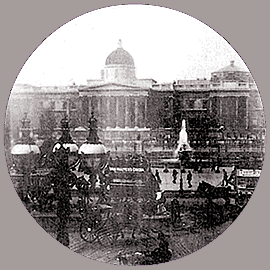 |
|
Wordsworth Donisthorpe filmed London’s Trafalgar Square traffic in 1890; these are the surviving 10 frames |
March 24, 2011 /Photography News/ Born 164 years ago today in Leeds, on March 24, 1847, Wordsworth Donisthorpe was an English individualist anarchist and inventor, pioneer of cinematography and chess enthusiast.
On 9 November 1876 Donisthorpe applied for a patent (B.P. 4,344) for the Kinesigraph, an apparatus ‘to facilitate the taking of a succession of photographs at equal intervals of time, in order to record the changes taking place in or the movements of the object being photographed, and also by means of a succession of pictures so taken … to give to the eye a representation of the object in continuous movement …’
Donisthorpe’s Kinesigraph camera was evidently inspired by the ‘square motion’ wool-combing machine designed by his father, with the ‘falling combs’ replaced with falling photographic plates. The camera was built, but how well it worked is not recorded.
On 24 January 1878, a letter from Donisthorpe, ‘Talking Photographs’, appeared in Nature, in which he suggested that his Kinesigraph, used in conjunction with Edison‘s recent invention the Phonograph, could produce a talking picture of Prime Minister William Gladstone.
Each individual photograph was to be illuminated by an electric spark and projected in sequence onto a magic lantern screen. The materials available for photography at that time did not lend themselves to motion picture work, and nothing else is heard from Donisthorpe on this subject until 1889, when he patented a film camera and projector.Louis Le Prince was living in Donisthorpe’s home town of Leeds, and it may be that word of Le Prince’s 1888 experiments revived Donisthorpe’s interest in the problem.
The patent for Donisthorpe’s new camera (B.P. 12,921), also called the Kinesigraph, was taken out jointly with William Crofts. It was a unique camera mechanism, which again had more in common with textile machinery than with other photographic devices. A shuttle carrying the film moved upwards as the film itself was pulled down, resulting in the film being stationary relative to the lens during each exposure. Development was entrusted to Crofts, and it was perhaps at a Camera Club lecture that he became aware of Eastman celluloid roll film. The new medium was ideal for their camera.
Some time between late 1889 and early 1891, Donisthorpe and Crofts set up their Kinesigraph in a building overlooking London’s Trafalgar Square, and shot at least one short film. It is an evocative, multi-layered view. Foaming water from one of the famous fountains is framed against a sooty background of the domed National Gallery building, with the bustling traffic of pedestrians and horse-drawn omnibuses; ten frames survive.
This footage has not been contested as the first motion picture ever taken of the city of London.
In 1894 William Crofts died, and any hope that might have remained for the eventual success of the Kinesigraph project died with him, Donisthorpe never being able to acquire backing for the project of moving pictures.
Donisthorpe later invented a new language (Uropa), and assisted his sons in experiments with colour and sound motion pictures. He died on 30 January 1914.